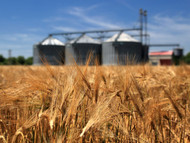The Key Differences Between Grain Bins and Grain Silos
Published by The Grain Handling Direct Team on Oct 18th 2022
Grain bins and silos have been quality and profitable farm staples for generations, but what do they do? In our explainer, we’ll break down the key differences between a grain bin and a grain silo, from why they have specific shapes to what farmers use them for.
Their Shape
Anyone who looks at a grain bin and a grain silo can tell you the first difference they notice is with their shapes. Grain silos have three shapes: bunkers, bags, and towers (the most common).
A grain silo tower is a tall, slender structure with a rounded roof that almost looks like a rocket, while a grain bin is a shorter, stouter structure with a peaked roof. The shapes of the structures explain their purposes. Silos are for fermenting grain and animal feed, while bins are for keeping grain products dry.
Their Structural Materials
Another key difference between grain bins and silos that anyone can see by looking at them is their structural materials. Since they’re shaped differently and have different functions, silos and bins are often made of distinct materials.
A grain bin is often made of smooth or corrugated metal. A silo is typically concrete, brick, wood, or sometimes metal since it’s much taller. Observers will also notice that grain bins typically have other structural accessories and equipment for loading and unloading grain products, such as grain leg towers.
Their Ventilation
Another reason bins and silos have different shapes is that they have different needs for airflow and ventilation. Grain bins must keep their grain products dry to avoid spoilage. Therefore, they often include state-of-the-art ventilation systems and fans to prevent condensation and moisture.
Grain silos are different because they’re for fermentation and don’t require extensive fan or ventilation systems. In fact, most grain silos are airtight.
Their Storage
The last difference between silos and bins we’ll explore is their primary function on farms and facilities. As we mentioned, the two structures of grain bins and silos have different shapes, constructions, and levels of ventilation because of their distinct purposes for farms.
Grain silos store silage, which includes grasses for fermented animal feed and other bulk food products. Grain bins store dry grain products, including:
- Barley
- Wheat
- Corn
- Soybeans
- Oats
While dry grain is for selling and is essential to a farm’s profitability, silage is for farm upkeep and maintenance and rarely leaves the property for selling.
If you have any further questions about grain bins or silos for your farm, don’t hesitate to ask the experts at Grain Handling Direct!

